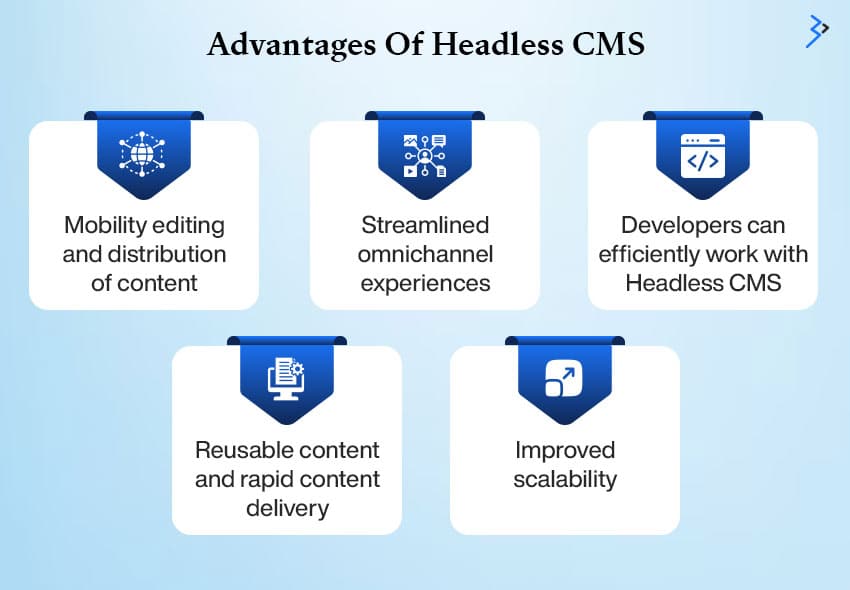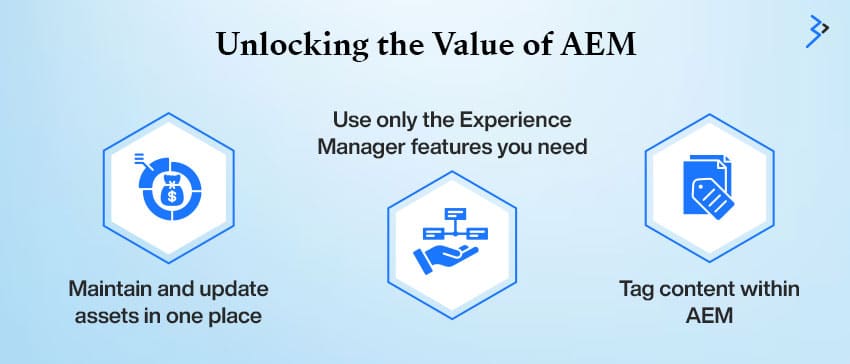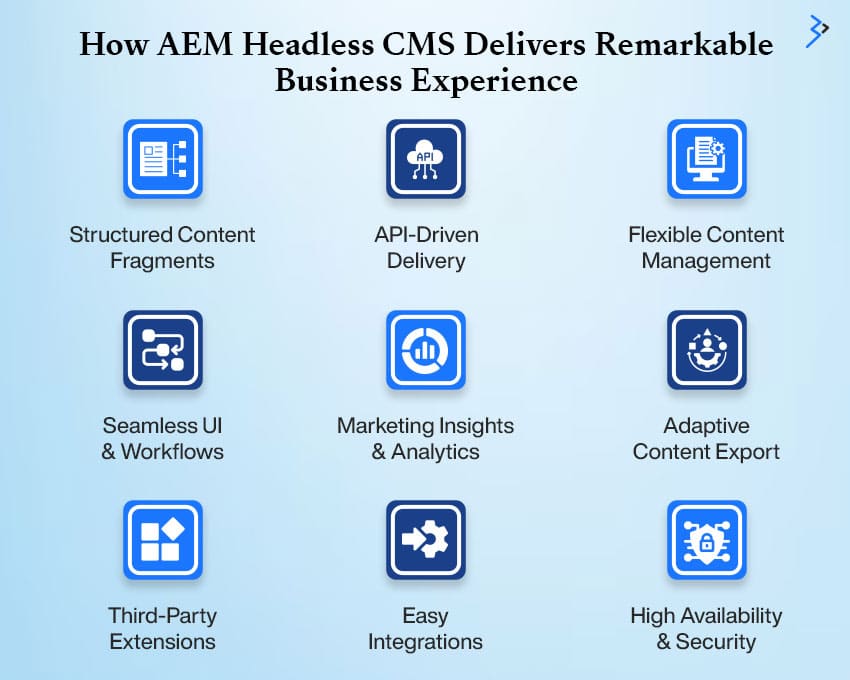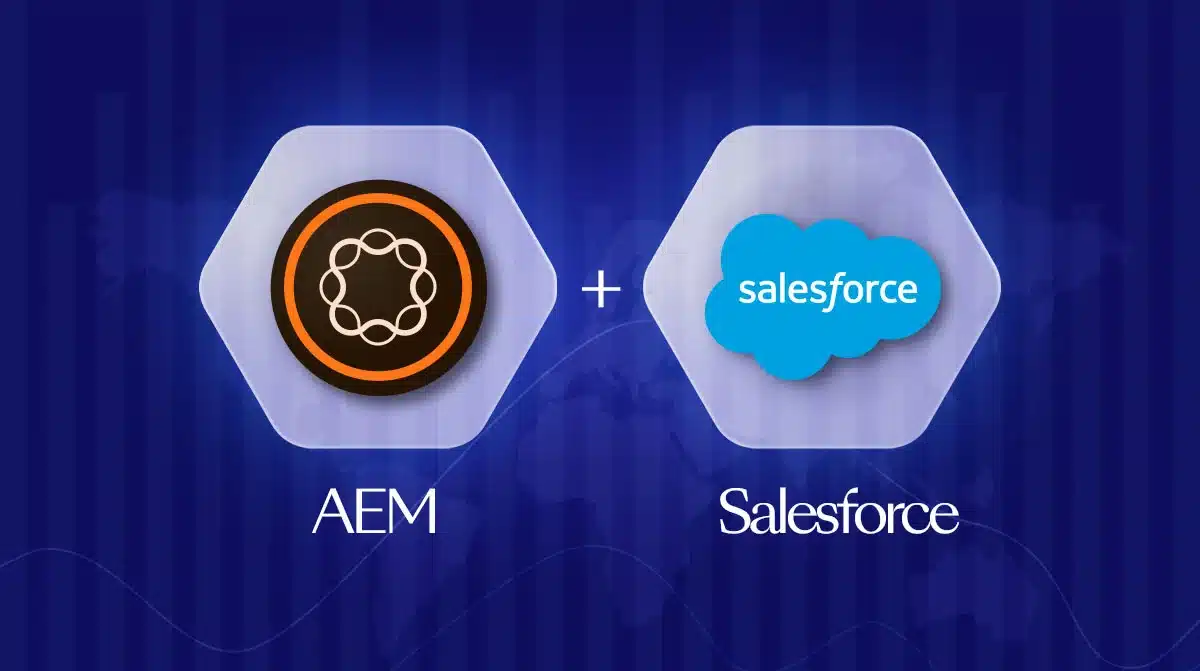In today’s business environment, a company’s internet presence is critical. A solid online presence may help your business expand by attracting new customers, generating revenue, and maintaining relationships with suppliers and partners. Your website needs a content management system (CMS) to satisfy all of your company’s goals and outperform the competition.
With Adobe Experience Manager services, you can combine the power of a content management system with the promise of digital asset management to create optimized, customer-focused, seamless experiences across all digital channels—social media, web, mobile, and email.
The headless AEM architecture approach separates AEM development services’ content management functionalities from their display layer. In contrast to traditional CMS installations, Headless AEM consulting services delegate content rendering and distribution to third-party apps via APIs, focusing solely on content storage, retrieval, and creation.
In this blog, we’ll explore the value of headless CMS with AEM. Continue reading as we learn more about it in the following sections.
Role of Headless CMS in the Digital Ecosystem
A headless CMS is a back-end-only system that exposes content over a RESTful API for display on any device. Unlike a standard CMS, it lacks a front-end layer or head, which often includes form fields or a WYSIWYG editor for determining how the content should appear or be structured on a webpage. Instead, the emphasis is on storing and distributing organized content.
This content can be delivered programmatically, added manually, or imported in bulk or via APIs. Once in the system, it is ready for dissemination to any platform, making it an adaptable solution for today’s multichannel digital ecosystem.
35% of businesses have already used this creative strategy.
A headless CMS may significantly improve your content marketing generation and distribution processes. It enables your team to use their production and channel resources, including developing technology. When content is required downstream, the system may make an API call to the headless CMS, obtain the content, and apply the appropriate style to that channel.
[ Read More: Why Does Adobe Experience Manager Matter ]
Why is a Headless CMS Recommended for Your Company?
Today’s consumers have evolving requirements, most of which cannot be satisfied by condensed, traditional content management systems. Given industry trends and insights, a headless CMS is the ideal solution for many expanding organizations.
A headless CMS allows content creators to have customizable editing and publishing access. Headless CMS systems are ideal for enterprises that operate across several platforms and want to develop omnichannel experiences. When choosing a headless CMS, some of the essential factors to consider are:
- Cache capacity, latency, and load time are all performance metrics for a website.
- The process of delivering content across channels becomes time-consuming.
- If your system demands many code hours, your current conventional CMS engineers cannot pick a front-end stack.
- If you believe that utilizing a standard CMS is holding you back, you would like a more responsive and efficient alternative.
[ Read More: Elevate your Adobe Experience Manager Sites Website with Generative AI Chatbots ]

Advantages Of Headless CMS
Customers’ expectations are increasing as digital interactions become more complex. To remain competitive, businesses must quickly provide dependable, dynamic, and responsive content. A headless CMS allows developers, marketers, and end users to create content more quickly.
Let’s understand how a headless CMS adds to your operations:
1. Mobility in the editing and distribution of content
APIs enable publishing or updating the same content across various applications, including IoT, SPAs, social media, and mobile apps, among others, without programming. Marketers may use headless CMS to publish campaigns and content using editing tools and templates to the appropriate frontend display layers.
2. Streamlined omnichannel experiences
Modern consumers interact with various daily interfaces, including computers, mobile devices, voice commands, and Internet of Things smart gadgets. Compared to republishing content manually across different platforms, the headless model saves time and effort by eliminating the front end and publishing information everywhere via APIs.

Instead of producing fresh content for every channel, marketers can concentrate on crafting distinctive experiences, delivering them at the appropriate time and location. This omnichannel experience could increase the total return on investment by raising client happiness and retention rates.
3. Developers can efficiently work with Headless CMS.
A headless CMS provides flexibility and independence while also simplifying development. It integrates with cutting-edge technology to create digital experiences and is intuitive, agile, and developer-friendly.
4. Reusable content and rapid content delivery
With Headless CMS, you can simultaneously send identical content to several platforms, utilizing low-code or no-code CDN APIs. By generating content in fragments, you may reach a larger audience, which ensures seamless experiences and brand consistency.
5. Improved scalability
A Headless CMS architecture is substantially more scalable. It includes a pre-built front end with highly optimized static pages and content, increasing its scalability by minimizing the costs, complexity, and risks of quickly delivering web pages.
[ Read More: Understanding the Cost of Adobe Solutions for Enterprise ]

Unlocking the Value of AEM
Using Adobe Experience Manager as a headless CMS in your digital content supply chain may help your business operate a more competitive content program and get a higher return on marketing efforts in various ways.
- Maintain and update assets in one place: Maintain and update assets in one location: With AEM’s customizable design, all of your digital assets can be integrated into a single area for simple maintenance and changes. You can easily manage your assets whether you use AEM as a regular CMS, a headless CMS, or a combination of the two. This involves the usage of ‘content fragments, ‘ which are organized content chunks that may be reused across several channels, adding to your content management process.
- Use as many or as few Experience Manager features as you need: AEM provides a wide range of capabilities, including content models and fragments and a content API for delivery. You may utilize as many or as few of these capabilities as you require to improve your content management and dissemination. Furthermore, AEM’s API-driven edge architecture allows you to combine the platform with other technologies and services, increasing your possibilities for developing unique experiences and compelling content.
- Tag content within AEM: Tagging your content in AEM makes it simple to query, locate what you need, and discover any content gaps your team has to fix. In addition, Adobe Commerce as a cloud service also allows you to construct a headless architecture with capabilities like content fragments, models, and a content API for delivery.
This feature set, including content models, fragments, and API-driven architecture, offers unparalleled capability, flexibility, and comprehensiveness. With Adobe Experience Manager as your headless CMS, your team can focus on developing personalized and relevant content while knowing that content management and distribution are handled.

How AEM Headless CMS Delivers Remarkable Business Experience
AEM development services, a headless CMS with a flexible and adaptable architecture, enable developers and marketers to create seamless customer journey experiences. AEM provides the framework for future growth while recognizing the need for headless content management for all enterprises.
Let’s discuss a couple of the headless CMS possibilities that AEM offers:
Fragments of structured content
Many businesses seek to send their content to clients quickly to gain a competitive edge. AEM headless CMS accelerates experience development and reduces time to market by using content fragments across the customer journey.
Delivering content with APIs
Content is delivered using robust APIs, like REST APIs and GraphQL, simplifying asset transformation and content management. With AEM, developers can employ ready-to-use, open-source SPA components to launch apps faster and spend less time maintaining them.
Handling various content alterations
AEM may help manage and develop personalized and consistent brand experiences across social media, the web, mobile applications, voice, in-person, and other platforms. By connecting live content copies to a master content structure, you may save time handling different variants of the same content.
Seamless UI
The present user interface supports advanced search and filtering and out-of-process extensibility, allowing you to configure it to meet your needs. Businesses may use Adobe Live Search, powered by Adobe Sensei, to give personalized product suggestions instantly and with lightning-fast search results.
Streamlined workflows
AEM assists developers in creating easy procedures by merging an agile content management system (CMS) with a modern data asset management system (DAM), which provides a content management foundation. It is simple to find content quickly, build designs, repurpose existing content and templates across all platforms, and deliver a personalized experience on a wide scale.
Examine the results of your marketing efforts.
Integrating Adobe Analytics with AEM allows you to link data and content. Adobe Analytics offers data and tools to improve intelligent seamless user experience, segmentation, contextual personalization, and optimization. By promoting your content and data, the integration assists you in determining which marketing initiatives will be most effective. By identifying target audiences and providing tailored information through their preferred touchpoints, sales may be enhanced.
Adaptive customization through content exporting
AEM’s headless CMS features enable the native export of experience fragments to Adobe Target for multivariate or A/B testing. Next, Adobe Target ensures all platforms deliver a consistent user experience for a single customer profile view. It provides tailored content at scale by establishing a single, progressive customer profile—even if customers check in across many channels using different credentials.
Extension via third parties
AEM headless CMS allows you to adapt websites to match your business needs using a third-party extensibility architecture that makes creating customized extensions straightforward. Adobe Developer App Builder expands AEM’s functionality by allowing for dynamic content on single-page apps with minimal load time latency. This link will enable you to move many assets from an external DAM to Adobe Experience Manager Assets. Developer App Builder will allow you to employ event-based triggers when an asset is created, updated, or withdrawn.
Simple integrations
AEM may be used with external technologies to track insights, perform A/B testing, personalize content, and perform other functions. Implementing Adobe Experience Clouds such as Adobe Campaign, Commerce, Analytics, Target, Sensei, Journey, and the Adobe Real-time Customer Data platform will help your firm boost its efficiency and flexibility.
Increased availability and security
AEM’s more secure headless CMS and your content production tools cannot access your content database to prevent cyberattacks. AEM headless CMS is also serverless, so you can access website content even when you’re not online.
Conclusion
In an age where digital experiences are everything, the CMS platform an organization chooses may significantly influence the success of its digital strategy. AEM CMS stands out as the leader in this industry because its all-inclusive solution allows organizations to create, manage, and deliver exceptional content experiences across all platforms.
AEM provides organizations the tools they need to flourish in the digital age, including excellent content management capabilities, innovative customization options, and seamless integration with Adobe Marketing Cloud and Analytics. Brainvire is committed to helping organizations realize the full potential of Adobe Experience Manager and achieve their digital objectives as an Adobe Partner.
Contact our experts to learn more about Adobe Experience Manager’s business-driven capabilities.
Related Articles
-
Integrate AEM with Salesforce: Your DIY Guide
Summary An organization is as successful as its software suite. Wonder why? Access to the best software allows organizations to streamline different aspects of their business and automate their workflow.
-
Using Adobe Commerce for B2B eCommerce: Features You Need to Know!
Summary Adobe Commerce (previously Magento) is a secure, flexible, and comprehensive enterprise eCommerce platform that allows you to create world-class B2C and B2B experiences, all from a single platform. Thanks
-
The Future of Automotive Sales – Personalized Journeys with Adobe Experience Cloud
Remember car shopping back in the day? Gone are the days of spending your entire Saturday hopping between dealerships, buried in brochures, and drained by endless negotiations. What was once




